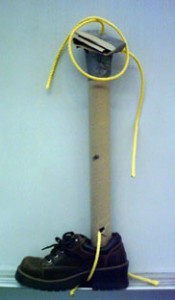Summary
Student teams investigate biomedical engineering and the technology of prosthetic. Students create a model prosthetic lower leg using various materials. Each team demonstrate its prosthesis’ strength and consider its pros and cons, giving insight into the characteristics and materials biomedical engineers consider in designing artificial limbs.
Engineering Connection
In everyday life, many people require replacement body parts. Those who need an artificial leg must have a structurally stable one to replace a critical part of their skeletal system. One aspect of biomedical engineering is designing and researching new and better prostheses (replacement body parts). Biomedical engineers are continually improving the strength, durability, longevity and life-likeness so amputees can lead full lives.
Materials:
Work Sheet For Group
For leg structure: toilet plungers (unused), plastic pipes, metal pipes, metal strips, cardboard tube (from wrapping paper roll), wooden “2 x 4,” thin metal duct material (to be rolled and taped into a tube shape), all generally 1.5 ft (or .46 m) long
For comfort: Large sponges, scrap bubble wrap, scrap cardboard, etc.
For lifelikeness: bath towels, pairs of pants, shoes (use students’)
For body attachment: String, rope, twine (about 30 ft [or 10 m])

